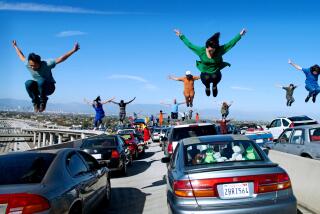Let There Be Light : Volunteers Have Bright Idea for Downtown Theaters
- Share via
S. Charles Lee, the architect of two of downtown Los Angeles’ most opulent movie palaces, reportedly once described the maintenance of the theaters’ hundreds of hard-to-reach interior lights as work best suited to “circus acrobats and monkeys.” It was a joking acknowledgement that the job demanded agility--and a certain fearlessness.
Eventually, however, the daredevil handymen who worked in the theaters grew old and died, and theater owners began to take a dim view of the cost of keeping all those dazzling chandeliers, sconces and floodlights glowing. Although the movies kept playing, the lights went out, turning downtown’s historic theaters into bleak caverns, dark even at intermission.
Lately, an illuminating change has occurred.
Inside five of the old film palaces--the Orpheum, Los Angeles, State, Palace and Million Dollar--long-unlit lights have begun shining again. They are aglow because of the efforts of a small group of historic theater devotees, whose obsession with restoring the landmarks has led them to crawl on wobbly catwalks in grimy attics, creep along narrow ceiling ledges and scale 50-foot ladders in the dark.
“We’re trying to recreate the look the theaters had when they opened in the 1920s and ‘30s,” said Jon Olivan, who is overseeing the effort. “We’re trying to bring back some of the magic.”
The realization that many of downtown’s 17 remaining theaters face a constant threat of closure or demolition only strengthens the group’s resolve.
“Without the lighting,” said Olivan, “people are not going to be able to appreciate the spectacular architecture. People have to become aware of their beauty in order to appreciate saving it.”
Olivan and about five others are doing the work mainly on a volunteer basis. Metropolitan Theaters, which operates the movie houses, is paying for materials.
The workers met through the Los Angeles Conservancy, a nonprofit preservation group that has sponsored special tours and film series in historic downtown theaters.
On a recent Friday morning, Olivan and three others assembled in the auditorium of the Orpheum, a 2,200-seat house that in its heyday played host to films of most of the movie greats of the 1930s, ‘40s and ‘50s, from Jack Benny to Judy Garland.
Their mission was to replace all 220 bulbs on a 16-foot-high, crystal-and-bronze chandelier--one of a pair that hang above the balcony.
On hand, aside from Olivan, were Ed Kelsey, a data processing analyst who, since becoming involved with the project, also moonlights part-time as the Orpheum’s stage manager; Steve Markham, a retired radio announcer, and John Farris, a camera assistant who works in television and film.
Two of them have personal links to the old theater. Markham, 68, once performed a baton-twirling act there when it was a vaudeville house. Farris’ mother danced in the Orpheum’s Christmas shows in the 1930s.
Markham, eyeing the enormous chandelier, said: “We take our lives in our hands a lot. These chandeliers can be a problem.”
To lower the chandelier, someone has to go into the attic, a labyrinth of beams and catwalks that end in sheer drops. The first time Markham and the others went up there more than a year ago, it was pitch-black--no fun.
On this day, Kelsey would clamber up and down a series of ladders in the attic to reach the hoisting device that controls the chandelier. It took Kelsey about five minutes to crank the winch and lower the fixture. His comrades waited on the balcony, wooden ladders and cartons of light bulbs at the ready.
This job was easy, compared to others.
Olivan termed the Los Angeles Theater, for instance, a nightmare for bulb-changers. Because most of the downtown theaters are not very profitable, they can’t afford to close for repairs. So Olivan and friends often work while the movie is playing.
When they went to change the lights in the auditorium of the Los Angeles, the feature was “Texas Chainsaw Massacre 3.” Imagine trying to scale a 40-foot ladder in the dark while hearing bloodcurdling screams and chain saws wreaking havoc on body parts.
“And I’m afraid of heights!” Olivan said, laughing, although he found little humor in the situation at the time. “It was like a Marx Brothers movie.”
There are some jobs even they consider too risky--such as tackling lights in a ceiling cove about 40 feet above the lobby of the Los Angeles. The only way to reach the lights was to tie a rope to a beam in the attic and scale the rope. Olivan said they recruited a special kind of electrician--one willing to take a class in mountaineering.
Olivan declined to give a figure for the amount Metropolitan has spent on the relighting. According to Metropolitan’s president, Bruce Corwin, the company supports the work mainly out of love for the old theaters and a desire to see them make a comeback.
Longtime downtown moviegoer Carlos Reyes, 40, said turning the lights on makes the theaters feel safer. He was one of about 30 people in the Los Angeles for a recent matinee performance of “Blind Fury.”
“I hope it brings more people in,” said Reyes, “because it’s beautiful in here.”
More to Read
The biggest entertainment stories
Get our big stories about Hollywood, film, television, music, arts, culture and more right in your inbox as soon as they publish.
You may occasionally receive promotional content from the Los Angeles Times.











